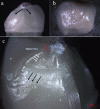Long-term fracture load of all-ceramic crowns: Effects of veneering ceramic thickness, application techniques, and cooling protocol
- PMID: 33262875
- PMCID: PMC7680567
- DOI: 10.4317/jced.57352
Long-term fracture load of all-ceramic crowns: Effects of veneering ceramic thickness, application techniques, and cooling protocol
Abstract
Background: To evaluate, in vitro, the effects of the cooling protocol, application technique, and veneering ceramic thickness on the fracture resistance of ceramic crowns with Y-TZP frameworks.
Material and methods: 80 frameworks were made from zirconia by the CAD/CAM technique and divided into 8 groups (n = 10) according to the factors: "application technique" (stratified-L and pressed -P), "thickness" (1 mm and 2 mm), and "cooling protocol" (slow-S and fast-F) of the feldspathic veneering ceramic. After, all crowns were cemented over G10 preparations with resin cement (Panavia F, Kuraray), mechanically cycled (2x106 cycles, 200 N, 3Hz), and subjected to the axial compression resistance test (0.5 mm/min, 10 kN). The data (N) underwent descriptive statistical analysis by 3-way ANOVA and Tukey's test (5%). Fracture analysis was performed to determine the possible origin of failure.
Results: The factors "cooling protocol" (P=0.0058) and "application" technique (P=0.0001) influenced the fracture resistance of the crowns. For pressed veneer technique, the P2S (4608.9±464.5). A presented significantly higher results than that P2F(3621.1±523.0)BCD (Tukey's test). For the stratified technique, this difference was not observed (P>0.05). The thickness of the veneering ceramic was not significant regardless of the cooling protocol and technique (P>0.05). The predominant failure mode was chipping of the ceramic veneer originating in the subsurface.
Conclusions: The pressed technique, used with a slow-cooling protocol, leads to the best outcome for the veneering of all-ceramic crowns. Key words:Zirconia, ceramics, cooling protocol, thickness, application technique.
Copyright: © 2020 Medicina Oral S.L.
Conflict of interest statement
Conflicts of interest None declared.
Figures



References
-
- Swain MV. Unstable cracking (chipping) of veneering porcelain on all-ceramic dental crowns and fixed partial dentures. Acta Biomater. 2009;5:1668–1677. - PubMed
-
- Soares LM, Soares C, Miranda ME, Basting RT. Influence of Core-Veneer Thickness Ratio on the Fracture Load and Failure Mode of Zirconia Crowns. J Prosthodont. 2019;28:209–215. - PubMed
-
- Swain MV, Mercurio V, Tibballs JE, Tholey M. Thermal induced deflection of a porcelain-zirconia bilayer: Influence of cooling rate. Dent Mater. 2019;35:574–584. - PubMed
-
- Örtorp A, Lindh Kihl M, Carlsson GE. A 3-year retrospective and clinical follow-up study of zirconia single crowns performed in a private practice. J Dent. 2009;37:731–736. - PubMed
LinkOut - more resources
Full Text Sources
Miscellaneous
